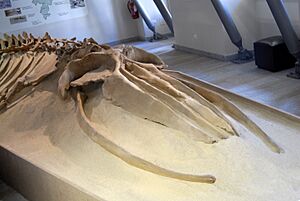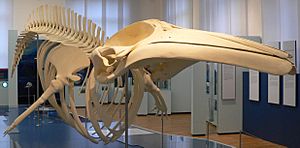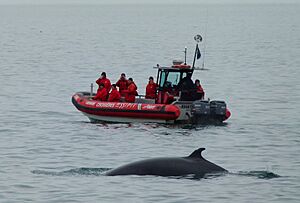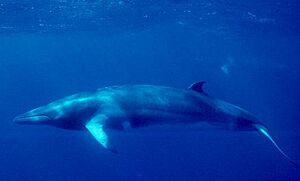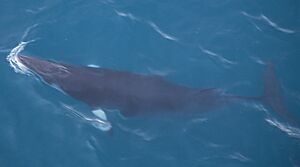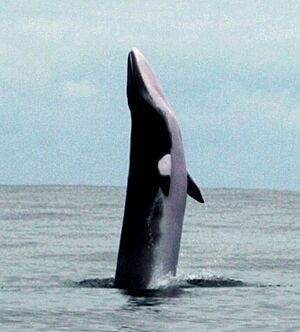Common minke whale facts for kids
Quick facts for kids Common minke whale |
|
|---|---|
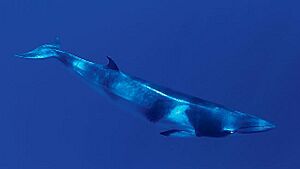 |
|
| A dwarf minke whale | |
 |
|
| Size compared to an average human | |
| Conservation status | |
| Scientific classification | |
| Genus: |
Balaenoptera
|
| Species: |
acutorostrata
|
| Subspecies | |
|
|
 |
|
| Common minke whale range | |
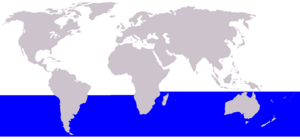 |
|
| Dwarf minke whale range | |
| Synonyms | |
The common minke whale or northern minke whale (Balaenoptera acutorostrata) is a type of minke whale and belongs to the group of baleen whales. It is the smallest of the rorqual whales and the second smallest of all baleen whales.
At first, whalers didn't hunt minke whales much because they were small and didn't provide much oil. But as other, larger whale species became scarce, people started hunting common minke whales more, mostly for their meat. Today, they are a main target for whaling. There's also a smaller version of this whale, called the dwarf minke whale, which lives in the Southern Hemisphere.
Scientists have found fossils of this species from about 3.6 million years ago, showing they have been around for a very long time.
Contents
What's in a Name?
The name "minke whale" has an interesting story. One idea is that it comes from a German sailor named Meincke. He worked for a famous whaler, Svend Foyn, who invented the grenade harpoon. Meincke supposedly mistook a group of these small whales for much larger blue whales. Because of this mistake, other sailors jokingly called these smaller whales "Minkie's whale."
This whale has also been called by other names, like the "little piked whale" or the "sharp-headed finner." In the 1800s, American whalers sometimes thought they were just young fin whales. In Germany, it's called "zwergwal," meaning "dwarf whale," and in Norway, "vågehval," meaning "bay whale." In Japan, it's "koiwashi-kujira" ("little sardine whale"), and in Greenland, "sildepisker" ("herring thresher").
Whale Family Tree
How Scientists Classified Them
The common minke whale was first described in 1780 by Otto Fabricius, who noticed its small size. Later, in 1804, Baron de Lacepede gave it the scientific name Balaenoptera acuto-rostrata. This name was based on a young female whale that washed ashore in France.
For a long time, all minke whales were thought to be one species. However, modern genetic tests using mitochondrial DNA showed that the common minke whale is actually a separate species from the Antarctic minke whale. These tests also confirmed that these two minke whale species are closely related.
When They Separated
Common and Antarctic minke whales split into two different species about 4.7 million years ago. This happened in the Southern Hemisphere during a period of global warming. This warming changed ocean currents and created separate areas, which helped the whales evolve into different groups. Common minke whales then spread into the Northern Hemisphere about 1.5 million years ago during a cooler period.
Mixed-Species Whales
Scientists have found two confirmed cases of hybrid whales, meaning they were a mix of common and Antarctic minke whales. Both were caught by Norwegian whalers in the North Atlantic. One was born from an Antarctic minke mother and a common minke father. The other had a common minke mother and an Antarctic minke father. This shows that these two species can sometimes interbreed.
What They Look Like
Size of Minke Whales
The common minke whale is the smallest of the rorquals. Only the Pygmy right whale is smaller among baleen whales. In the North Atlantic, they usually grow to about 9.4 to 10.05 meters (31 to 33 feet) long. Some older reports claimed longer whales, but these were likely measured differently. In the North Pacific, the longest males measured about 8.5 meters (28 feet) and females about 9.1 meters (30 feet).
Dwarf minke whales are a bit smaller. The longest dwarf male was about 7.62 meters (25 feet), and the longest female was 7.77 meters (25.5 feet).
When they are born, minke whales are about 2.5 to 2.8 meters (8 to 9 feet) long and weigh between 150 and 300 kilograms (330 to 660 pounds). They are usually weaned (stop drinking milk) when they are about 4.57 meters (15 feet) long. Dwarf minke whales are estimated to be about 2 meters (6.5 feet) long at birth.
Appearance Details
Northern Form
Common minke whales have a strong body shape. Their snout is narrow and pointed, like a triangle. They have a tall, curved dorsal fin (the fin on their back) that is about 30 centimeters (12 inches) high. This fin is located about two-thirds of the way down their back.
Their color is dark gray on top and clean white underneath. The lower jaw sticks out a bit and is dark gray. They have a light gray V-shaped mark on their back, called a "shoulder streak," located between their front fins. Their pectoral fins (side fins) are relatively small and have a clear white band on the outer edges. This white band is a key feature that helps identify them. Their tail flukes (the two halves of their tail) are smooth, about 2 meters (6.5 feet) wide, and are light gray or white underneath with dark gray edges.
They have about 230 to 360 pairs of baleen plates in their mouths. These plates are creamy white with a fine white fringe. Baleen plates are like giant combs that help them filter food from the water. They also have 50 to 70 thin grooves on their throat, which stretch out when they feed.
Dwarf Form
The dwarf minke whale has a similar body shape to the northern form, with a curved dorsal fin. It has 55 to 67 throat grooves. Its baleen plates are mostly white, but some of the back plates can be dark gray on the outer edges.
Dwarf minke whales have very complex coloring. They have dark gray areas mixed with light gray and white patches and streaks. The most noticeable features are the white "flipper" and "shoulder blazes." The flipper blaze covers most of the pectoral fin and continues along its front edge. The shoulder blaze connects to a light gray patch on their chest. They often have a white patch on the back corner of their right lower jaw, called a "mandible blaze," and sometimes a white patch around their right eye.
They also have a thin, light gray line on their back, called a "nape streak," which can point forward or backward. This helps identify individual whales.
Where They Live
Their Home Range
Common minke whales live in different parts of the world. In the North Atlantic, they are found as far north as Baffin Bay and Svalbard, and as far south as New Jersey in the summer. They are sometimes seen in the Gulf of Mexico and the Mediterranean Sea. In winter, they are found in warmer waters like off Bermuda and the Bahamas.
In the western and central North Pacific, they range from Hawaii and the East China Sea in the south to the Sea of Okhotsk and Bering Sea in the north. In the eastern North Pacific, they live from the Gulf of Alaska down to Baja California.
The dwarf form of the minke whale lives in the Southern Hemisphere. They have been seen off Brazil, Uruguay, Argentina, Chile, South Africa, Australia, New Zealand, and even as far south as the South Shetland Islands near Antarctica.
How Many There Are
North Atlantic
There are estimated to be over 180,000 common minke whales in the North Atlantic. Surveys from 1996 to 2001 estimated about 107,205 whales in the Northeastern Atlantic. Around Iceland, there are an estimated 67,225 whales. Off Western Greenland, there are about 4,856 individuals. In the Gulf of Saint Lawrence, about 1,020 minke whales were estimated in the mid-1990s. More recent estimates from 2021 suggest up to 150,000 individuals in Norwegian waters, which is higher than previous numbers.
North Pacific
Surveys in the Okhotsk Sea and Northwest Pacific in 1989-1990 estimated about 25,049 minke whales. In the central Bering Sea, there were about 936 individuals in 1999. Off the coast of British Columbia, about 475 whales were estimated in 2004-2005.
Southern Hemisphere
It's hard to count dwarf minke whales because they are often confused with the more common Antarctic minke whale. So, there are no specific population estimates for them.
Where They Stay
Staying in One Place
Minke whales can be identified by the unique shape of their dorsal fin, marks on their body, and small scars. Studies in North America, Scotland, and Iceland showed that individual whales often stay in the same small areas for long periods. For example, in the San Juan Islands of Washington state, many whales were seen repeatedly in the same sub-regions over several years. Some whales, however, moved more freely between different areas.
Traveling Whales
Minke whales also travel long distances. Three whales tagged off Iceland showed large movements. One traveled over 3,700 kilometers (2,300 miles) in just over 100 days, reaching near the Cape Verde Islands. In the eastern North Pacific, some whales moved between different feeding areas along the coast.
Four dwarf minke whales tagged off the Great Barrier Reef in Australia traveled south along the coastline. One of them traveled about 6,000 kilometers (3,700 miles) before its tag stopped working.
How They Live
Reproduction and Life Cycle
Common minke whales become ready to have babies at about six to eight years old for females, and six to seven years for males. Females usually mate with different males. After being pregnant for 10 months, a single calf is born, measuring about 2.6 meters (8.5 feet) long. The calf drinks milk for about six months.
In the North Atlantic, most babies are conceived in February and born in December. In the North Pacific, conception is usually between October and March, and calving is from December to July, depending on the specific group. Females can have a calf every year, so they are often pregnant and still nursing a previous calf at the same time.
Minke whales can live to be about 50 years old. The oldest ones found in a study off Iceland were 42 for females and 47 for males.
What They Eat
Common minke whales mainly eat small schooling fish, like herring and capelin, as well as tiny shrimp-like creatures called krill. Their diet changes depending on where they are, the season, and the year.
North Atlantic
In the North Atlantic, they mostly eat small schooling fish and krill. Off Spitsbergen, they primarily eat krill, but also some capelin. Off Bear Island and in the southern Barents Sea, capelin is their main food. In the North Sea, they mostly eat sandeel and Atlantic mackerel. Off Iceland, their diet includes sandeel, haddock, herring, and capelin.
North Pacific
In the North Pacific, small schooling fish and krill are also important. They eat Pacific herring in the northern Okhotsk Sea and Alaska pollock east of Sakhalin Island. They also consume Japanese mackerel and Pacific saury. Around the western Aleutian Islands, krill makes up most of their diet. Off Hokkaido, they eat krill, sardines, and sand lance.
Southern Hemisphere
In the Southern Ocean, dwarf minke whales mainly eat myctophid fishes, which are small deep-sea fish. They also eat krill.
Who Eats Them
Killer whales are known to hunt and attack common minke whales. Minke whales often try to escape by swimming very fast in open water. If they get trapped in a bay, killer whales might ram them until they drown. Chases usually last about 30 minutes to an hour, with both whales swimming up to 30 kilometers per hour (18.6 mph). Typically, two to four killer whales hunt a single minke whale. If caught, minke whales usually don't fight back. Killer whales often only eat the tongue, skin, and some blubber of the minke whales they kill.
Sometimes, minke whales try to hide under boats to escape killer whales, but they are not always successful.
Other Dangers
Minke whales can also die from other causes. They sometimes get caught in fishing nets, traps, or lines. This has been reported in many places, including Korea, Japan, Canada, and the United States. Many of the whales caught in fishing gear are young ones.
Collisions with ships are another danger. This has happened off the east coast of the United States and in the Gulf of St. Lawrence.
Minke whales can also get sick. In 2007, a young female minke whale died from poisoning after eating anchovies that had a harmful toxin. In 2013, a young male whale died after eating plastic debris that blocked its digestive system. Since 2017, there has been an increase in minke whale strandings (when they get stuck on shore) along the Atlantic coast of the United States. Scientists are investigating these events, and while human interactions and diseases are sometimes found, the exact cause is not fully understood.
How They Act
Group Size
Common minke whales are usually seen alone. Even when several whales are in a feeding area, they often act independently. Sometimes, two whales might surface together, but this usually doesn't last long. Groups of more than three whales are rare. Cow-calf pairs (mother and baby) are also not often seen in many areas.
Northern minke whales sometimes jump completely out of the water, which is called breaching. One whale was seen breaching eight times in a row when killer whales approached.
Dwarf minke whales are also usually seen alone or in pairs. On the Great Barrier Reef, they have been observed approaching dive boats and even circling divers in the water. They also breach. Off Brazil, they usually avoid whale watching boats and fishing vessels.
Where Different Whales Go
Minke whales often separate by sex, age, and whether they are pregnant. For example, off Greenland, more females are found on the west coast, especially further north. Most of these females are mature and pregnant. Males are more common on the east coast.
Off Iceland, males are more common in most areas, while females are slightly more numerous on the east coast. In the northeastern North Atlantic, females are more common around Svalbard, while males are more common near the British Isles and Norway. Larger whales tend to be found further north, and smaller ones further south.
In the western North Pacific, larger whales are usually found in higher latitudes (colder waters), while smaller whales, especially females, are found in lower latitudes (warmer waters).
How They Surface and Dive
When a minke whale comes to the surface to breathe, its pointed snout appears first. It might exhale before or as it breaks the surface, creating a narrow puff of air. Then, it quickly arches its back before diving deeper. Often, both its blowholes and dorsal fin can be seen at the same time.
Depending on what they are doing (traveling, searching for food, or feeding), they might breathe anywhere from one to seven times quickly before taking a longer dive. When traveling, they take more breaths and longer dives. When feeding, they take fewer breaths and shorter dives, often changing direction and swimming vigorously.
Feeding Styles
Minke whales use different techniques to catch their food. In the Gulf of St. Lawrence, they use "entrapment maneuvers" and "engulfment maneuvers."
Entrapment maneuvers involve swimming in circles, ovals, or figure-eights to herd fish. For example, in a "circle," a whale swims on its side, mouth open, in a circle, trapping fish inside.
Engulfment maneuvers are how they actually catch the food. This includes different types of lunges:
- Plunges: The whale approaches the water at a shallow angle, with only its snout and part of its lower lip showing as it breaks the surface.
- Oblique lunges: The whale comes out of the water at a steeper angle, showing its throat grooves. Sometimes, its whole body jumps out of the water.
- Lateral lunges: The whale breaks the surface on its side.
- Vertical lunges: The whale comes out of the water at a 90-degree angle.
- Ventral lunges: The whale exits the water on its back.
Plunges are the most common feeding lunge.
In the Saguenay Fjord National Park, scientists observed new feeding techniques. These included:
- Head slaps: The whale lifts its head high out of the water and then slams it down, making a loud splash. This might help herd fish.
- Chin-up blows: The whale comes high out of the water to breathe and dive in one smooth motion.
- Exhale on the dive: The whale exhales as its blowholes go underwater, displacing a lot of water.
These new techniques might help the whales herd small schooling fish in certain water conditions.
Whale Sounds
North Atlantic
In the North Atlantic, minke whales make "downsweeps" (sounds that go from high to low frequency) and "pulse trains" or "thump trains." Downsweeps last about 0.4 seconds. Pulse trains are a series of quick pulses. These sounds have been recorded in places like the St. Lawrence estuary and Massachusetts Bay. They are heard most often from mid-July to mid-November.
North Pacific
In the North Pacific, minke whales make unique sounds called "boings." These sounds were first heard in the 1950s but their source was a mystery for decades. They consist of a short "precursor" pulse followed by a longer, complex "AM component." These sounds are mostly recorded from October to May, peaking in March. In the early 2000s, scientists finally confirmed that minke whales make these "boing" sounds.
Southern Hemisphere
Dwarf minke whales in the Southern Hemisphere produce a complex and unusual sound called the "star wars" vocalization. It sounds "almost synthetic, metallic, or mechanical." This sound has been recorded off the Great Barrier Reef in Australia. They also make downswept calls.
Whaling History
North Atlantic
People have been hunting minke whales off Norway since at least 1100 A.D. In the 1920s, Norwegian fishermen started catching them from small boats. By the late 1930s, this hunting spread to the Barents Sea, which became a very important whaling area. At its peak, over 300 vessels hunted minke whales each season. The number of whales caught peaked at 4,338 in 1958. Over 125,000 minke whales have been caught by Norwegian commercial whalers since 1938.
Commercial whaling was paused in 1987 due to a worldwide ban, but Norway resumed commercial whaling for minke whales in 1993. They typically catch 450 to 600 whales each year.
Iceland also started catching minke whales in 1914, mostly for their meat. They caught over 3,362 whales between 1914 and 1980. Iceland also resumed commercial whaling for minkes in 2006.
Off Newfoundland, Canada, minke whales were hunted from 1947 to 1972, with a peak of 97 whales caught in 1972. Greenlanders also started hunting minke whales in 1948, mainly for local food. They caught over 3,434 whales between 1948 and 1976. Today, Greenland still catches about 150 to 190 whales annually.
North Pacific
In Japan, minke whaling by small boats began in 1930. Several hundred minkes were caught each year, with a peak of 532 in 1956. A total of 13,334 were caught by Japanese coastal whalers between 1948 and 1987. Most were caught off Sanriku and Hokkaido. Commercial whaling ended in 1987, but Japan began catching minke whales for scientific research in 1994, continuing to the present day.
Whaling for minke whales off Korea began in the early 1930s. Catches increased significantly in the 1970s, peaking at over 1,000 whales in 1977 and 1978. About 16,000 minke whales were caught off Korea between 1940 and 1986, when hunting stopped.
The Soviet Union also caught a small number of minke whales in the western North Pacific.
Southern Hemisphere
Few dwarf minke whales have been caught by whalers. Thirteen were caught off Durban, South Africa, between 1970 and 1973. Out of 902 minke whales caught off northeastern Brazil in 1980, only three were dwarf minkes. Japanese expeditions in the sub-Antarctic also caught a small number of dwarf minkes between 1987 and 1993.
Conservation Status
The common minke whale is listed as "Least Concern" by the IUCN Red List. This means it is not currently considered to be at high risk of extinction.
The species is also protected by international agreements like the Memorandum of Understanding for the Conservation of Cetaceans and Their Habitats in the Pacific Islands Region and the Agreement on the Conservation of Cetaceans in the Black Sea Mediterranean Sea and Contiguous Atlantic Area.
Images for kids
-
Whale eyeball (Balaenoptera acutorostrata).
-
Whale Tongue (Balaenoptera acutorostrata).
-
Whale lung (Balaenoptera acutorostrata).
-
Whale kidney (Balaenoptera acutorostrata).
-
Whale artery (cut) (Balaenoptera acutorostrata).
See also
- List of cetaceans
- List of whale vocalizations
- Marine biology



